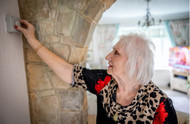Home Upgrades You Can Make to Save Energy Next Winter
16th May 2023
Any home can benefit from improving insulation and making some updates with the intention of improving energy efficiency, and anytime before next winter is the time to do it.
Truth is, improving your home’s insulation, sealing gaps and air leak points, and making the other improvements mentioned here will help in the summer, too, when you’re trying to keep the cooler air in.
So, with that said, here are some of our top tips for improving your home to boost energy efficiency through the winter, from adjusting your fans to installing a high-efficiency convection heater such as our Envi wall-mounted panel heaters.
1.Get an energy audit
The first thing you’ll want to do if you’re serious about making upgrades is to conduct an energy audit by partnering with a professional.
Getting an audit will pinpoint the exact areas that you need to focus your attention to improve your home’s insulation.
An auditor will likely take a look at your home’s walls, flooring, and ceiling, as well as doors and windows and other areas in which air can leak in or out.
Specialists may even use tools like infrared cameras to confirm areas of suspected weak insulation, in areas where you can’t see - like behind walls.
Audits also usually are accompanied by an official report that will detail all of the potential improvements you can make that will keep your home warmer in the winter to improve thermostatic control and save you money.
2. Fill gaps in your existing insulation

Sealing gaps in your home’s insulation is likely the most important thing you can do to improve your home’s energy efficiency.
Even if you don’t get an energy audit, you can still walk through your home and look for areas where the insulation may need to be filled, repaired, or improved.
The attic is a key area of interest, especially in the winter, as heat rises, and attics also sometimes are unfinished. If your attic’s ceiling is not insulated, that is something you will want to redress.
The roofing itself also makes a difference. There are now energy-efficient roofs and roofing materials on the market; if your roof needs work, consider some of these options.
Other areas of concern include garages and other exterior walls. If the garage has uninsulated walls, consider adding fiberglass or spray foam insulation that can serve as an easy improvement to your home’s insulation.
As for other exterior walls, if you suspect that a specific wall in your home is leaching energy, feel the wall on a particularly hot (or cold) day - if it feels warm (or cool), it may be because there is a gap in the insulation. This is something you may need to work with a professional to fix, though.
3. Install weatherstripping/Seal air leakage points/Gaps around windows
The walls themselves are not the only areas in which heat can get in or out of your home.
If you have old windows, there could be gaps around them that leak hot and cold air. Even high-quality modern doors can let air in and out. If your budget allows for it, it might make sense to replace the old, leaky windows or doors.
Alternatively, weather-stripping is cheap, readily available, and easy to install. This is a great option to seal any gaps around leaky doors or windows. You don’t need to be a professional to install this stuff.
There are other areas that can leak hot and cold air - such as the holes around outlets that may not be properly sealed. The gaps around switches and light fixtures, and even pipes, can also leak air - but fortunately are easy to seal with spray-style insulation.
Other air leakage points may be present in crawl spaces and around exterior foundations. These should come up during an energy audit but are also generally easy to plug up with insulation.
4. Adjust your fans to spin in reverse during the winter
One easy tip we can also recommend to improve your home’s energy efficiency in the winter is to reverse your ceiling fan’s direction.
In the winter, when you’re heating the house, the warm air rises - this is true whether you are using a forced air heater with a fan, a space heater, or a fanless model like one of our Envi convection heaters that work without fans or blowers.
In larger spaces and rooms with high ceilings, all that warm air will gather near the ceiling, where it won’t do you any good.
Most fans have a switch setting that allows them to spin in the opposite direction, which will push the hot air down from the ceiling and towards the living area - this should be clockwise - and is a simple step you can take to improve the comfort of your home.
5. Install a convection heater

Last but not least, if your home has some other heating system like a furnace or electric baseboard, consider installing a convection heater, like one of our Envi heaters, as either a replacement or a supplement.
Even if only as a supplement, our stack convection heaters have a lot of benefits. For one, they enable you to use “zone heating” so you don’t heat empty rooms. They are also easy to install, require no maintenance, and are extremely economical - only costing 4 to 5 cents per hour to run.
They are also safe for use around seniors, pets and children, have no moving parts that can break, and use a heating element that does not circulate dust and allergens like forced-air central heating systems.
They’re even made here in the United States and covered with a 3-year warranty.
If you have any other questions about our Envi wall-mounted convection heating systems, contact us at 1-800-807-0107.












